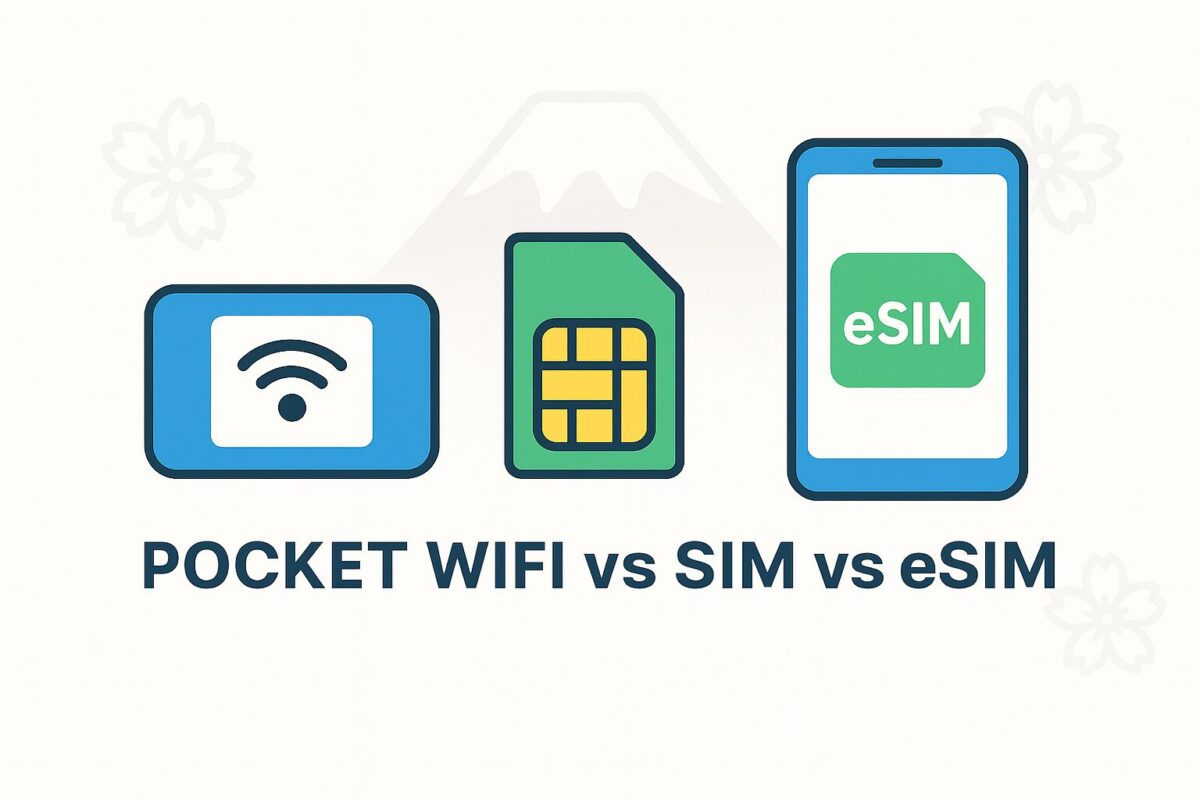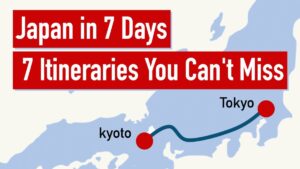Staying connected during your trip to Japan is essential — from navigating the subway to sharing your adventures or keeping in touch with family.
But what’s the best way to get reliable internet? Should you rent a Pocket WiFi, buy a SIM card, or try the latest eSIM technology?
As someone who has lived in Japan for 33 years, I’ve seen travelers struggle with connectivity more times than I can count. Here’s what actually works best — from a local’s perspective.
Which internet option is best for you?
Are you traveling alone?
3 Main Ways to Get Internet in Japan
Before you choose your internet option for Japan, it’s essential to understand the pros and cons of each method.
Whether you’re considering renting a Pocket WiFi, buying a Japanese SIM card, or setting up an eSIM before your trip, knowing the differences can save you time, money, and stress during your journey.
Below, we break down the three main ways to get internet in Japan so you can decide which solution fits your travel style and budget best.
What is Pocket WiFi?
Pocket WiFi is a portable WiFi router you carry with you, letting multiple devices connect to Japan’s 4G/5G network.
Advantages:
- Great for families or friends traveling together.
- Easy to set up: turn it on and go.
- Many plans offer “unlimited” data, which can be a lifesaver.
 Flo
Flo“I’ve lent Pocket WiFi to friends visiting from abroad countless times. They loved being able to share one connection for their phones, laptops, and even cameras uploading photos.”
- Needs to be picked up and returned (usually at the airport or hotel).
- Battery might not last a full day of heavy use.
- A bit bulky compared to SIM/eSIM.
Best for families or groups who want to share one device.
[See our in-depth guide: Top 5 Pocket WiFi Devices for Japan]
What is a SIM Card?
A SIM card replaces the one in your phone and gives you a Japanese number and data plan. You’ll need an unlocked phone.
Advantages:
- Direct connection — no extra device to carry.
- Often cheaper than Pocket WiFi for solo travelers.



“For short solo trips, I’ve recommended SIMs to friends who didn’t want to worry about carrying another gadget. But you do need to be sure your phone is unlocked — some visitors were caught off guard.”
- Won’t work on locked devices.
- Usually comes with limited data plans.
- Installing it can be fiddly if you’re not confident with tech.
Perfect for solo travelers with unlocked phones.
What is an eSIM?
An eSIM is a digital SIM you install on your phone before or during your trip — no physical card needed.
Advantages:
- Instant activation, no pickup or return needed.
- Lets you keep your home SIM active if your phone supports dual SIMs.



“Lately, my tech-savvy friends just download an eSIM plan before boarding their flight. They land connected, and it’s honestly the simplest way I’ve seen.”
- Only works with newer, eSIM-compatible devices.
- Some travelers find the QR code setup process confusing.
Best for travelers who want hassle-free connectivity with modern phones.
Comparison Table: Pocket WiFi vs SIM vs eSIM
| Feature | Pocket WiFi | SIM Card | eSIM |
|---|---|---|---|
| Average price | ¥500–¥1,000/day | ¥2,500–¥5,000 (1–2 weeks) | ¥1,500–¥4,000 (1–2 weeks) |
| Data limit | Often unlimited | Typically 3–10GB or unlimited | Typically 1–20GB or unlimited |
| Setup | Turn on, connect | Insert SIM, restart phone | Download, scan QR, activate |
| Device compatibility | Any WiFi-capable device | Unlocked phones only | eSIM-compatible phones only |
| Sharing ability | Supports multiple devices | One device only | One device only |
| Pickup/Return | Yes (airport/hotel) | Often mailed or picked up | Delivered digitally |
Best Internet Option for Different Travel Styles
- Short-term trips & backpackers: SIM or eSIM for simplicity and affordability.
- Long-term stays (2+ weeks): Pocket WiFi for cost-effective unlimited data.
- Families & groups: Pocket WiFi makes sure everyone stays online together.
- Business travelers & digital nomads: eSIM for fast, convenient setup without pickup lines.
- Heavy data users (streaming, video calls): Pocket WiFi with truly unlimited plans.



“For heavy social media users or those uploading videos daily, Pocket WiFi’s unlimited data really pays off. But for minimal browsing, SIM or eSIM is often enough.”
Essential FAQs Before Choosing
Before you choose your internet option for Japan, here are answers to the most common questions travelers have. Knowing these can help you avoid surprises and make your trip smoother and stress-free.
- Where can I pick up Pocket WiFi when I arrive in Japan?
-
You can easily pick up your Pocket WiFi at major airports including Narita, Haneda, Kansai, and Chubu Centrair. Providers usually have clear counters or kiosks in the arrival halls, so you can start using the internet right after landing.
- What’s the difference between a SIM card and an eSIM?
-
A SIM card is a small plastic chip you insert into your phone, while an eSIM is a digital SIM you download — no need to wait for shipping or pick up anything at the airport. With an eSIM, you can set up your connection before you even leave home.
- Will I really get unlimited data, or is there a catch?
-
Some plans advertise “unlimited” data but slow your speed if you exceed a certain amount per day (for example, 3–10GB). Always read the details of your plan so you know what to expect and avoid surprises.
- Is it easy to return a rented Pocket WiFi device?
-
Yes — you can usually drop it off at the airport before you leave, in a dedicated return box or at the same counter you picked it up from. Some companies even let you leave it at your hotel front desk. It’s a simple process that takes only a minute.
- How can I check if my phone works with eSIMs in Japan?
-
If you have an iPhone XR or newer, Google Pixel 3 or newer, Samsung Galaxy S20 or newer, or some recent Oppo/Huawei models, you’re good to go. Not sure? Check your phone’s specs on the manufacturer’s website or ask your carrier before your trip.
Conclusion – Which Internet Option is Best for You?
- Choose Pocket WiFi if you’re traveling with family or want unlimited data for multiple devices.
- Choose a SIM card if you’re a solo traveler with an unlocked phone.
- Choose an eSIM if you have a compatible phone and want the most convenient, instant option.
Flo’s comment:



“Having helped countless friends visiting Japan, I know each traveler’s needs are different — but choosing the right internet option can make or break your experience.”
Ready to get connected?
Check the best Pocket WiFi deals here
Find your perfect Japan SIM card here
Discover the best eSIMs for Japan here









Comments